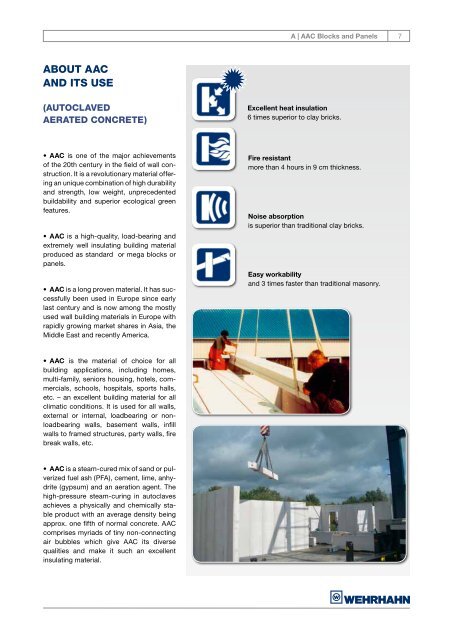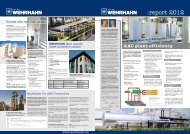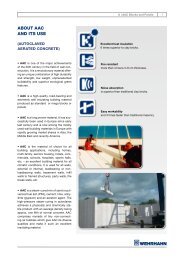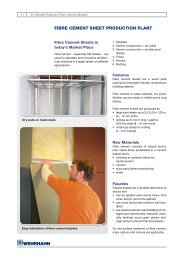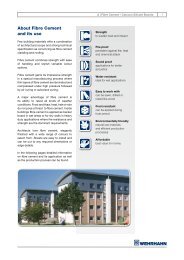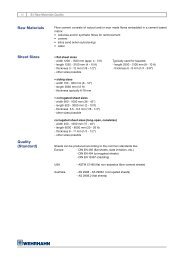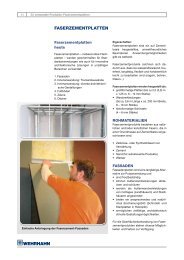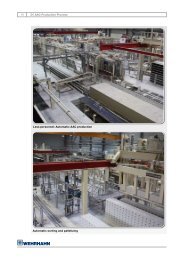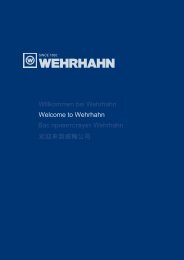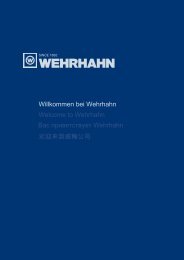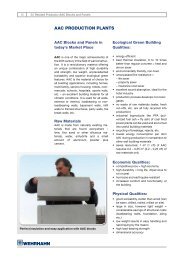PDF 240 Kb - Wehrhahn
PDF 240 Kb - Wehrhahn
PDF 240 Kb - Wehrhahn
You also want an ePaper? Increase the reach of your titles
YUMPU automatically turns print PDFs into web optimized ePapers that Google loves.
ABOUT AAC<br />
AND ITS USE<br />
(AUTOCLAVED<br />
AERATED CONCRETE)<br />
• AAC is one of the major achievements<br />
of the 20th century in the field of wall construction.<br />
It is a revolutionary material offering<br />
an unique combination of high durability<br />
and strength, low weight, unprecedented<br />
buildability and superior ecological green<br />
features.<br />
• AAC is a high-quality, load-bearing and<br />
extremely well insulating building material<br />
produced as standard or mega blocks or<br />
panels.<br />
• AAC is a long proven material. It has successfully<br />
been used in Europe since early<br />
last century and is now among the mostly<br />
used wall building materials in Europe with<br />
rapidly growing market shares in Asia, the<br />
Middle East and recently America.<br />
• AAC is the material of choice for all<br />
building applications, including homes,<br />
multi-family, seniors housing, hotels, commercials,<br />
schools, hospitals, sports halls,<br />
etc. – an excellent building material for all<br />
climatic conditions. It is used for all walls,<br />
external or internal, loadbearing or nonloadbearing<br />
walls, basement walls, infill<br />
walls to framed structures, party walls, fire<br />
break walls, etc.<br />
• AAC is a steam-cured mix of sand or pulverized<br />
fuel ash (PFA), cement, lime, anhydrite<br />
(gypsum) and an aeration agent. The<br />
high-pressure steam-curing in autoclaves<br />
achieves a physically and chemically stable<br />
product with an average density being<br />
approx. one fifth of normal concrete. AAC<br />
comprises myriads of tiny non-connecting<br />
air bubbles which give AAC its diverse<br />
qualities and make it such an excellent<br />
insulating material.<br />
A | AAC Blocks and Panels<br />
Excellent heat insulation<br />
6 times superior to clay bricks.<br />
Fire resistant<br />
more than 4 hours in 9 cm thickness.<br />
Noise absorption<br />
is superior than traditional clay bricks.<br />
Easy workability<br />
and 3 times faster than traditional masonry.<br />
7
8<br />
A | AAC Blocks and Panels<br />
QUALITIES OF AAC<br />
BLOCKS AND PANELS<br />
Compare always cost and features of a<br />
ready-installed wall of AAC with a wood<br />
stick wall or a wall of bricks or concrete<br />
blocks. The finished AAC wall features all<br />
benefits, such as:<br />
Ecological green building<br />
Qualities:<br />
• energy efficient<br />
• best thermal insulation, 6 to 10 times<br />
better than regular concrete = heat and<br />
aircon saver<br />
• environmentally friendly, non-toxic<br />
• unsurpassed fire-resistance =<br />
– life saver<br />
– property saver<br />
– insurance cost saver<br />
• excellent sound absorption, ideal for the<br />
hotel industry<br />
• production process develops non-toxic<br />
gases<br />
• no waste of raw materials (water, fresh<br />
cut-offs, etc. are all fully recycled into<br />
production)<br />
• industrial byproducts like PFA (pulverized<br />
fuel ash = fly ash) of coal fired<br />
Unsurpassed Fire-rating (average)*:<br />
Block thickness, (mm)<br />
minimum (inch)<br />
Fire-rating (hours)<br />
Non-load bearing wall DIN*<br />
ASTM**<br />
50<br />
(2)<br />
75<br />
(3)<br />
power plants can be used and are turned<br />
into useful building materials<br />
• recycling of breakage, rejects, etc.<br />
• lowest energy consumption per cbm<br />
(cft) during production in comparison to<br />
other wall building materials<br />
• saves resources: 1 m 3 (1 cft) of AAC<br />
requires 0,2 – 0,25 m 3 of raw materials<br />
only (0,2 – 0,25 cft)<br />
Economic Qualities:<br />
• competitive price = high economy<br />
• high durability = long life, impervious to<br />
rot or pest<br />
• hurricane and earthquake resistant<br />
• increased comfort and functionality of<br />
the building<br />
Physical Qualities:<br />
• good workability, better than wood (can<br />
be sawn, drilled, nailed, milled on site)<br />
• large in size, however light weight =<br />
considerable savings of structural costs<br />
(loadbearing walls, foundation, piling<br />
etc.)<br />
• low weight results in easy handling and<br />
rapid laying by the mason<br />
• high load-bearing strength<br />
• dimensional accuracy<br />
115<br />
(4 1 /2)<br />
150<br />
(6)<br />
0,5 1 – 1,5 2 3<br />
4<br />
4 4 4<br />
Load bearing wall DIN* 0,5 – 2 1 – 3 1,5 – 2 2 – 3 3<br />
175<br />
(7)<br />
200<br />
(8)<br />
<strong>240</strong><br />
(10)
… MORE ABOUT AAC?<br />
ENERGY EFFICIENCY<br />
Great Energy Efficiency<br />
High energy efficiency is one of the determining<br />
characteristics of autoclaved aerated<br />
concrete. AAC‘s cellular structure gives<br />
it a thermal efficiency 10 times higher than<br />
that of aggregate concrete and six times<br />
better than clay brick. Consequently, buildings<br />
made of AAC are warm in winter and<br />
cool in summer.<br />
With buildings consuming 40% of global<br />
energy, greater use of AAC, both in construction<br />
and renovation, offers an immediate<br />
solution to cutting the energy consumption<br />
of residential and non-residential<br />
buildings across the globe.<br />
AAC‘s excellent inherent thermal insulation<br />
properties not only reduce the need<br />
for heating and cooling, thereby cutting<br />
carbon dioxide emissions and combating<br />
climate change, but also make the use of<br />
additional insulation materials unnecessary.<br />
EU insulation requirements can be<br />
met by using AAC alone. By contrast, aggregate<br />
concrete, clay brick and calcium<br />
silicate masonry units need to be used<br />
in combination with insulation products,<br />
thereby adding to their cost and environmental<br />
impact.<br />
AAC is energy-efficient over its whole life<br />
cycle. Its production requires less energy<br />
than other construction materials and its<br />
light weight saves energy in transportation.<br />
Because of the considerable thermal mass<br />
AAC has the ability to store and release<br />
energy over time. An increased comfort in<br />
climates where outdoor temperatures fluctuate<br />
strongly over a 24 h period.<br />
FIRE RESISTANCE<br />
Excellent Fire resistance<br />
Autoclaved aerated concrete provides the<br />
highest security against fire and meets the<br />
most stringent fire safety requirements.<br />
Due to its purely mineral composition, AAC<br />
is classified as a non-combustible building<br />
material. It is both resistant to fire up to 1200° C<br />
and, unlike other construction materials,<br />
heat-resistant.<br />
Therefore AAC can be used as a fire wall<br />
to prevent fire from spreading, thereby<br />
protecting lives and economic assets. In<br />
principle a fire wall should last up to four<br />
hours, but tests have shown that an 150<br />
mm thick AAC fire wall can resist at least<br />
for six hours. In a real blaze, an AAC fire<br />
wall even survived intact for 120 hours.<br />
Some insurance companies offer reductions<br />
in fire premiums for buildings<br />
equipped with AAC fire walls.<br />
In addition to internal fire walls, constructing<br />
outer walls of AAC contributes significantly<br />
to fire safety as most blazes start<br />
outside buildings.<br />
Besides being fire- and heat-resistant, AAC<br />
does not give off any smoke or toxic gases,<br />
which can endanger human life more than<br />
fire itself.<br />
STRUCTURAL<br />
PERFORMANCE<br />
Outstanding structural<br />
Performance<br />
Autoclaved aerated concrete is extremely<br />
strong and durable despite its light weight.<br />
AAC‘s solidity comes from the calcium silicate<br />
that encloses its millions of air pores<br />
and from the curing process in a pressurised<br />
steam chamber (autoclave). Its excellent<br />
mechanical properties make it the<br />
construction material of choice for earthquake<br />
zones.<br />
AAC‘s light weight ensures that the foundations<br />
of a building are lightly loaded, yet<br />
it is strong enough to bear several floors.<br />
It retains its properties for the entire life<br />
of a building. AAC resists wind, rain and<br />
storm and does not decay or rot. In general,<br />
changing outside temperatures cannot<br />
damage AAC.<br />
A | AAC Blocks and Panels<br />
9
10 A | AAC Blocks and Panels<br />
RESOURCES<br />
Autoclaved Aerated Concrete (AAC) is an<br />
environmentally responsible building material<br />
that conserves material and energy<br />
usage in manufacture as well as energy efficiency<br />
of the building.<br />
High resource Efficiency, low<br />
environmental Impact<br />
Autoclaved aerated concrete‘s high resource<br />
efficiency gives a low environmental<br />
impact in all phases of its life cycle, from<br />
processing of raw materials to the disposal<br />
of AAC waste.<br />
Raw Materials<br />
AAC is made from naturally existing materials<br />
that are found everywhere<br />
– lime, fine sand, other siliceous materials,<br />
water and a small amount of aluminium<br />
powder (manufactured from<br />
a by-product of aluminium) – plus<br />
cement.<br />
Production<br />
Thanks to continuous efficiency improvements,<br />
production of AAC demands relatively<br />
small amounts of raw materials per<br />
m 3 of AAC (1 m³ of raw materials results in<br />
Consumption of raw materials and energy needed for production of<br />
building materials *<br />
1600<br />
1400<br />
1200<br />
1000<br />
800<br />
600<br />
400<br />
200<br />
0<br />
Clay bricks<br />
p = 1,2 kg/m 3<br />
Consumption of raw materials in kg/m 3<br />
Consumption of energy in kWh/m 3<br />
5 m 3 of finished AAC), 5 times more than<br />
any other construction products. No raw<br />
materials are wasted in the production<br />
process and all production offcuts are fed<br />
back into the production circuit.<br />
The manufacture of AAC requires less energy<br />
than for all other masonry products,<br />
thereby reducing use of fossil fuels and associated<br />
emissions of carbon dioxide (CO 2 ).<br />
Energy is also saved in the curing process<br />
since AAC is steam cured at relatively low<br />
temperatures and the hot steam generated<br />
in the autoclaves is reused for subsequent<br />
batches. Industrial-quality water is used<br />
and neither water nor steam are released<br />
into the environment. Non-toxic gases are<br />
created in the production process.<br />
Transportation<br />
AAC‘s light weight also saves energy in<br />
transportation. As AAC is up to five times<br />
lighter than concrete and two to three times<br />
lighter than clay brick CO 2 emissions are<br />
significantly reduced during transport.<br />
Reuse, Recovery and<br />
Disposal<br />
Throughout the life cycle of AAC, potential<br />
waste is reused or recycled wherever possible<br />
to minimise final disposal in landfill.<br />
Porous clay<br />
masonry units<br />
p = 0,8 kg/m 3<br />
Calcium silicate<br />
masonry units<br />
p = 1,4 kg/m 3<br />
AAC<br />
masonry units<br />
p = 0,4 kg/m 3<br />
*Source: FeBeCel handbook 2000: Le Béton Cellulaire – Matériau d’ Avenir, p. 32
Blocks<br />
• length up to 625 mm (2 ft)<br />
• height 200 – 400 mm (8‘‘ to 16‘‘)<br />
• thickness 50 – 400 mm (2‘‘ to 16‘‘)<br />
Megablocks<br />
• length 625 to 1250 mm (2 ft to 4 ft)<br />
• height 625 mm (2 ft)<br />
• thickness 100 – 400 mm (4‘‘ to 16‘‘)<br />
Panels<br />
• length<br />
– floor high 2.50 – 4.30 m (8 ft to 14 ft)<br />
as vertical wall panels<br />
– long up to 6.00 m (20 ft)<br />
as horizontal or vertical wall and roof/floor panels<br />
• width 625 mm (2 ft)<br />
• thickness 75 – 300 mm (3“ to 12“)<br />
Strength class<br />
according<br />
to DIN<br />
*Density *Average Compressive<br />
Strength<br />
Thermal<br />
Conductivity<br />
t/m³ lb/cft N/mm² psi W/mk (BTU·in/ft²h°F)<br />
PP2-035 0.35 22 2.5 350 < 0.11 < 0.76<br />
PP2-040 0.40 25 2.5 350 0.11 0.76<br />
PP2-050 0.50 30 2.5 350 0.14 0.97<br />
PP4-055 0.55 33 5.0 700 0.14 0.97<br />
PP4-060 0.60 35 5.0 700 0.16 1.11<br />
PP6-070 0.70 40 7.5 1000 0.18 1.24<br />
*Ref. DIN 4165<br />
Note: The compressive strength and density to be achieved depend on the raw material quality and on the mix<br />
formula.<br />
Strength<br />
Class<br />
Nominal Dry<br />
Bulk Density<br />
Density<br />
Limits<br />
Compr.<br />
Strength<br />
psi (MPa)<br />
Average<br />
Drying<br />
Shrinkage<br />
Thermal<br />
Resistance<br />
(8 in. wall<br />
thickness)**<br />
R-value<br />
lb/ ft³/ kg/ m³ lb/ ft³/ kg/ m³ min (%) (hft² °F/BTU)<br />
AAC-2 25 (400) 22–28 (350)–(450) 290 (2.0)<br />
31 (500) 28–34 (450)–(550) 11.5 – 9.2<br />
AAC-4 31 (500) 28–34 (450)–(550) 580 (4.0) ≤ 0.02<br />
37 (600) 34–41 (550)–(650) 9.2 – 7.4<br />
44 (700) 41–47 (650)–(750)<br />
50 (800) 47–53 (750)–(850)<br />
AAC-6 37 (800) 35–41 (550)–(850) 870 (6.0)<br />
44 (700) 41–47 (650)–(750) < 7.4<br />
50 (800) 47–53 (750)–(850)<br />
Ref. ASTM: C1386-07<br />
**including air film coefficients<br />
A | AAC Blocks and Panels<br />
TYPICAL<br />
SIZES<br />
(other sizes<br />
possible)<br />
EUROPE<br />
11<br />
Physical<br />
Characteristics<br />
(DIN EN)<br />
USA<br />
Physical<br />
Characteristics<br />
(ASTM:<br />
C1386 - 07)


